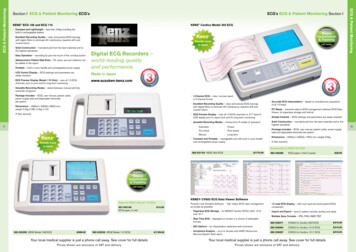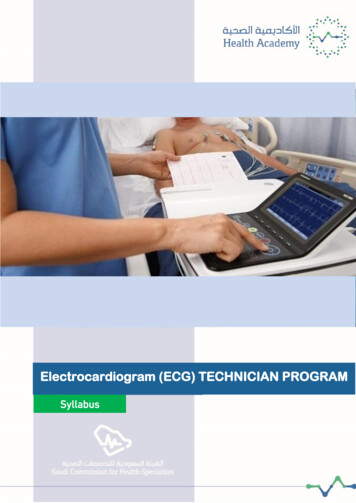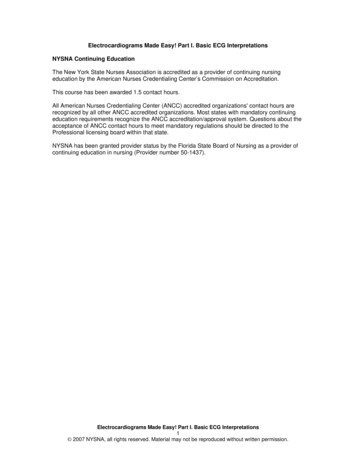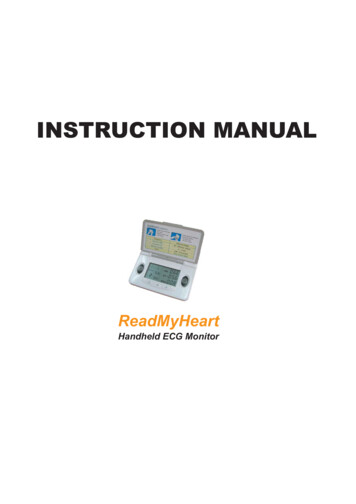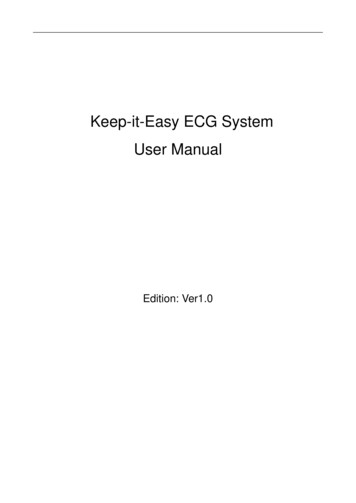
Transcription
Keep-it-Easy ECG SystemUser ManualEdition: Ver1.0
Content1. General Introduction. - 4 2. Requirements For Running Keep-it-Easy ECG System . - 4 3. Installation . - 4 4. Software Operation . - 7 4.1 Main menu . - 8 4.2 Main Functions Introduction . - 9 4.2.1 Patient Records . - 9 4.2.2 Real Time View . - 10 4.2.3 ECG Strip View . - 13 4.2.4 Analysis View . - 14 4.2.5 Help . - 18 4.2.6 Register. - 18 4.2.7 About System . - 19 4.2.8 Close . - 19 -5. Uninstall . - 19 --2-
NoticeThank you for purchasing the Keep-it-Easy ECG System software which is the datamanagement software for our ECG monitor. Before use, please read this manual carefully.Beijing Choice Electronic Technology Co., Ltd. (hereinafter called Beijing Choice) owns allrights to this unpublished work and intends to maintain this work as confidential. BeijingChoice may also seek to maintain this work as an unpublished copyright. No part of this canbe disseminated for other purposes. In the event of inadvertent or deliberate publication,Beijing Choice intends to enforce its right to this work under copyright laws as a publishedwork. Anyone who is not authorized by Beijing Choice cannot copy, use, or disclose theinformation in this manual. Content of the manual is subject to change without prior notice.All rights reserved.DeclarationAll information contained in this publication is believed to be correct. Choice shall not beliable for errors contained herein nor for incidental or consequential damages in connectionwith the furnishing, performance, or use of this material. This publication may refer toinformation and protected by copyrights or patents and does not attorn any license underthe patent rights of Beijing Choice, nor the rights of others. Beijing Choice does not assumeany liability arising out of any infringements of patents or other rights of third parties.-3-
1. General IntroductionKeep-it-Easy ECG System is the application software running on a computer in conjunctionwith the handheld ECG monitor. You can use the software on your computer to analyze,display, replay, export, import and print data transferred from the ECG monitor.2. Requirements for Running Keep-it-Easy ECG SystemTo run the Keep-it-Easy ECG System, your computer requires a hardware configurationwith a minimum of PIII500 CPU, 64M internal memory, CD-ROM drive, a minimum of a 10Ghard disc.Requirement for Operating System:Microsoft Windows 2000/XP/Vista operating system.3. Installation3.1Insert the attached installation CD into your computer’s CD-ROM driver.3.2Single click the “setup.exe” files to access the installing interface as in Fig.3-1.Fig.3-13.3Click the “Install Keep-it-Easy ECG System” button to install the software. Refer tosteps 3.3.1 3.3.6 for installation instructions:-4-
3.3.1Fig.3-2 Click “Next ”3.3.2Fig.3-3 Click “Next ”-5-
3.3.3Fig.3-4 Click “Next ”3.3.4Fig.3-5 Click “Next ”-6-
3.3.5Fig.3-6 Click “CloseIn the interface as in Fig.3-6 click the “Close” on to finish the installation steps.3.3.6 After finishing installation of the software, a shortcut icon “Keep-it-Easy ECGSystem” will appear on your computer’s desktop, refer to Fig.3-7. You can run it bydouble-clicking the shortcut icon or by clicking the “Keep-it-Easy ECG System” menuitem in the “Start” menu of your PC.Fig. 3-74. Software OperationThe Keep-it-Easy ECG System is the application software running on a computer togetherwith the ECG monitor. It will only allow one ECG monitor to be connected to the computerfor data transmission at a time.You can use the software for reviewing and analyzing data that was previously uploaded toit without having an ECG monitor attached to your computer.-7-
The required computer resolution is 1024 768 or higher.4.1 Main menuDouble-click the “Keep-it-Easy ECG System” icon to run the software; the main menu willbe displayed as shown in Fig. 4-1.Fig. 4-1Description of Fig. 4-1::Analysis ViewBy accessing this menu item, you can review data and waveform in continuousmeasurement mode.:ECG Strip ViewBy accessing this menu item, you can review data and waveform in easy mode.:Real Time ViewBy accessing this menu item, you can view real-time data and waveform.:Patient RecordsBy accessing this menu item, you can manage patients’ records.:Help-8-
By accessing this menu item, you can learn some general ECG knowledge.:Register (Optional)By accessing this menu item, you can activate the function of the analysis of arrhythmiatype by inputting correct register code.:About SystemBy accessing this menu item, you can get some information about the software system.:CloseBy clicking the “Close” icon, you will exit from the software system.4.2 Main Functions Introduction4.2.1 Patient RecordsClick theicon in the main menu, the window displayed in Fig. 4-2 will pop up. In thiswindow, the user can modify the patient’s information including name, gender and birth dateand so on, but the patient ID cannot be modified. The user can also delete any existingpatient’s information and add new ones.Fig. 4-2Screen Description:On the Patient Records screen, the user can modify and delete any existing patientinformation as well as add new ones. The table on the left area of the screen is the Patient-9-
list; the right area of the screen is the detailed patient information for the selected storedpatient archive. The following are descriptions of each field:Patient ID: Displays the patient ID, the length of Patient ID is less than 10 characters.Name:Displays the patient’s name; the length of the name should less than 40characters.Gender:Displays the gender of the patient. Select Male or Female from thedrop-down list.Birth Date: Displays the patient birth date, the length of the birthday should less than 40characters.Height:Displays the patient’s height; the length of the height should less than 10characters.Weight:Displays the patient’s weight; the length of the weight should less than 10characters.Telephone: Patient’s telephone number; the length of the phone number should lessthan 40 characters.Address:Patient’s address; the length of the address should less than 60 characters.Allergies: Description of patient’s allergy symptoms; the length of the allergy fieldshould less than 60 characters.Case History:Description of ECG diagnostic result; the length of words should lessthan 200 characters.Functional buttons:Add:You can add new patient’s information by pressing this button.Modify:Modify the selected patient’s information from the patient list.Delete:Delete the patient and his/her data selected from the patient list.Back:Exit from the current screen.Note: The Patient ID cannot be changed once saved.4.2.2 Real Time Viewicon to enter the submenu interface, refer to Fig. 4-3. InOn the main menu, click thethis interface, the user can view the real-time data measured by the ECG monitor and savethem into the PC for reviewing and management.1.Please connect the ECG monitor to the PC well before activating this function.- 10 -
Fig. 4-32.To save the real-time transferred data, be sure to check the “Real-time save”check-box, or else the data will not be saved.3.After checking the “Real-time Save” check-box, click the Start button, “Select theUser” pop-up window will be displayed, refer to Fig. 4-4. Select a user that youwould like to save data for.Note: If you want to save the real-time measured data, please be sure to check the“Real-time save” box in the interface as shown in Fig. 4-4, or else, the data will not besaved.- 11 -
Fig.4-4Select a patient from the table and click the “OK” button, then the data transmission willbegin and the transferred data will be saved in the selected user archive. Refer to Fig.4-5.Fig.4-5The real-time data is shown as in Fig. 4-5. “HR” is the heart rate. The area of “Arrhythmia”will display the arrhythmia analysis result if you additionally purchase the register function.“Lead Status” indicates the connection status of the current lead. “ECG Speed” is the scanspeed of ECG waveform. The rest items are patient information.Note: if you want to purchase the register function, please contact our company.Functional buttons:There are three functional buttons including Start, Stop and Return.Start:Starts the real-time ECG recording and transmission from the ECG monitorto the software.Stop:This button allows the user to terminate the real-time monitoring.Back:Exit from the current screen.If the real-time monitoring is interrupted because of any other reason, the system mayprompt you with the following window as in Fig. 4-6. You can restart the transmissionprocess by clicking the “Start” button after checking the connection between the ECGmonitor and your PC.- 12 -
Fig. 4-64.2.3 ECG Strip ViewBefore performing the function, please make sure the monitor has been connected to PCwith USB cable and the monitor has been activated and the power of batteries is sufficient.Click theicon in the main interface to access its submenu interface, and then click the“Read Data” button, the software system will begin to read data from the ECG monitor.Refer to Fig. 4-7.Fig. 4-7Note: Please do not disconnect the USB cable or operate the monitor so as to keepthe data transferring continually during the data transferring.After finishing data transmission, the system may prompt that the data transmission hasbeen finished successfully! The data that has been transferred into the software will bedisplayed in the left area of the interface. When the reading is finished, you can select somedata item(s) and save them into archive by clicking the “Import ECGs” button. A window asshown in Fig. 4-4 will pop up; you can add new users by clicking the “Add User” button. Its- 13 -
specific operations are the same as the introduction in “4.2.1 Patient Records”.Note: Please make sure to save the transferred data items into the software by clicking the“Import ECGs” button, or else, the data may fail to be saved into the software when exitingfrom the current interface.4.2.4 Analysis View4.2.4.1 Data ReplayClick the “” icon to enter the submenu interface. And then click the “” icon of thetoolbar which is on the top of the interface to replay ECG waveform. The interface is asshown in Fig. 4-8.When you want to view someone’s ECG wave, select his/her archive in archives list on theright by clicking its row. And then all the ECG belonging to this user will be displayed on theleft area. Every row of contractible ECG wave on the lower left displays ECG wave for 30seconds.Fig. 4-8From the interface as shown in Fig.4-8, the user may review the ECG wave measured inthe continue mode. For example as in Fig.4-8, the user can use a green selecting box to- 14 -
select a section of ECG wave. Shift mouse and click any dot in ECG wave can pitch on thesection of ECG wave, then its amplificatory wave will be displayed on the above wave boxand its corresponding record information (its heart rate value and measuring “Time” of theoriginal record) will be shown on the right area of the interface.V-scale Amplify: The user can review the different proportional display of the section ofECG wave by setting the display scale. By clicking the “Last Page” or the “Next Page”button, the user can view the previous or next page data items.Additionally, measurement analysis and patient(s)’ information also may be displayed onthe right area.What’ s more, the user can print the current selected record and ECG wave or the currentselected page of records and ECG wave by clicking the “Print Report” button.4.2.4.2 Record ManagementClick the “” icon of the toolbar to switch to the “ECG record management” interface,such as in Fig.4-9.Select a patient archive whose data you want to view in the table on the left top of theinterface, the data items belonging to this patient will appear in the table on the lower left ofthe interface. Refer to Fig.4-9.You can also select a data item that you want to view from the list that located in the leftarea of the interface, and then the corresponding ECG wave will be displayed on the rightarea. Every data item displays ECG wave for 30 seconds. Refer to Fig.4-9.- 15 -
Fig.4-9When there are too many users in the archive list, the user can use the function of “Query”to search the user archive that is needed. Two query conditions are provided by the system,Patient ID and Name. Input the correct patient ID or name into the edit-box on the right, andthen click the “Query” button to search the corresponding patient.Functional buttons:Delete:The user can delete the current record(s) of the current user by clicking thisbutton.Import:By clicking this button, the user can import the record(s) that has beensaved on the PC to the software for reviewing and management.Export:By clicking this button, the user can export the current record(s) of thecurrent user to PC with the extension of .cEcg or .bmp.4.2.4.3 ECG waveform analysis” icon of the toolbar to switch to the ECG waveform analysis interface asClick the “shown in Fig.4-10.- 16 -
Fig.4-10Description of Fig.4-10:The patient information table is on the left side of ECG waveform. Select the target in it, andthen the right will show the corresponding ECG waveform. According to these waveforms,the ECG waveform analysis will be shown above, including the results of HR, ST, PR, ORS,QT and QTC. You can also choose a specific part of the waveforms to see the analysis byclicking on the waveforms.Functional buttons:Print analysis: The user can print the ECG analysis results by clicking the “” iconin the toolbar.Save analysis as picture:The user can save the analysis as picture to the PC withthe extension of .bmp, .jpeg, .gif, .tiff, or .png by clicking the “” icon inthe toolbar.Email picture to:The user can email the analysis as picture to the mailbox you inputby clicking the “” icon in the toolbar.Print preview: The user can preview the ECG waveforms and analysis before printingby clicking the “” icon in the toolbar. The preview interface as shown inFig.4-11.- 17 -
Fig.4-114.2.5 HelpYou can obtain the troubleshooting instructions and general knowledge about ECG byclicking theicon in the main menu interface.4.2.6 RegisterThe arrhythmia type analysis function is optional and not included in the standard package.If you have bought the function, you need to apply a register code which is necessary toactivate the arrhythmia type analysis function.You can see the following interface in the “Version” menu of the ECG monitor. Refer toFig.4-12. Return the SN code to our company for Register Code, then you will gain theRegister Code from us.Fig. 4-12How to activate ECG analysis function of the ECG monitor:Access the dialog box as shown in Fig.4-13 by clicking theicon of “Register”, andinput the Register Code in the editable box, then click the “OK” button.- 18 -
Fig. 4-134.2.7 About SystemClickicon to access the information interface.4.2.8 CloseClickicon to exit from the Keep-it-Easy ECG System.5. UninstallClick the “Start” menu of Windows system to find the Keep-it-Easy ECG System programgroup, then click the “Uninstall” item and the following prompt will appear as in Fig.5-1.Click the “Yes” button in Fig.5-1, then the uninstall will be finished.Fig. 5-1Manufacturer address:Beijing Choice Electronic Technology Co.,Ltd.Bailangyuan Building BRm. 1127-1128, Fuxing Road, A36100039 BeijingPEOPLE’S REPUBLIC OF CHINA- 19 -
4. Software Operation . The Keep-it-Easy ECG System is the application software running on a computer together with the ECG monitor. It will only allow one ECG monitor to be connected to the computer for data transmission at a time. You can use the software for reviewing and analyzing data that was previously uploaded to
